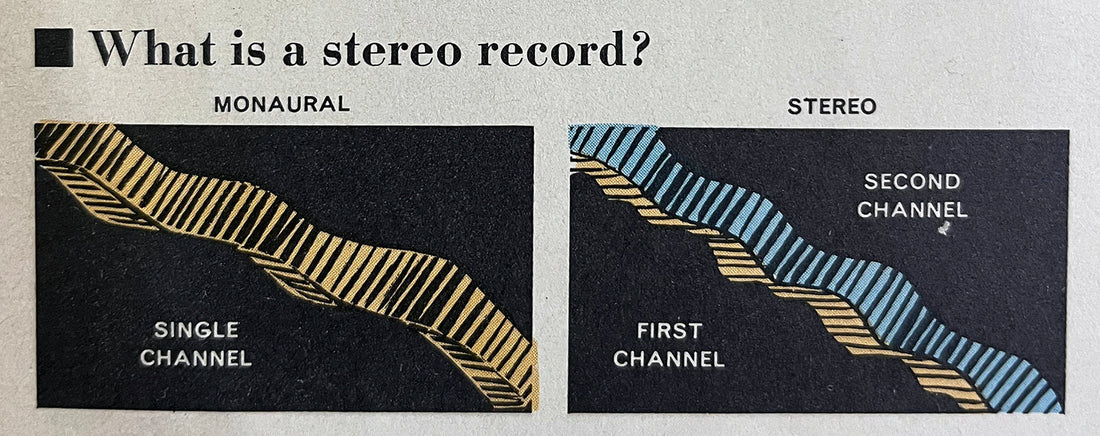In the days before digital music, the primary medium for sound reproduction was the vinyl record. Sure, there were some who went with reel-to-reel tapes, but they were in the minority. The turntable was ubiquitous, and records had to be properly cared for. In the 1950s and 1960s, album inner sleeves often contained instructions for record care and/or other pertinent information.

As stereophonic sound was being introduced, a number of record companies figured it was a good idea to educate the record-buying public about the process and its sonic advantages. RCA, the Radio Corporation of America, was a pioneer in recorded sound, broadcasting, and electronics. From its roots with the Marconi Wireless Telegraph Company of America (American Marconi) and General Electric, through its establishment of the National Broadcasting Corporation (NBC), followed by the purchase of The Victor Talking Machine Company, to its re-acquisition by General Electric in the 1980s, RCA was (and still is) a household name (especially in crossword puzzles). Today, it primarily exists as a brand name licensed to other manufacturers. Audiophiles will also recognize it as the plug designation of standard single-ended audio interconnects. This inner sleeve is from a late 1950s/early 1960s RCA Victor album.

Decca Records and EMI were the pre-eminent labels in British recording. Decca is infamous for turning down the Beatles when they were getting started, leading to the band’s albums being issued by EMI/Parlophone. Both Decca and EMI were highly regarded primarily classical labels. In the 1960s and early 1970s, albums were issued in both mono and stereo formats. As evidenced by the Decca sleeve shown, the company took educating the public about equipment and record care quite seriously. You might wonder about the blue square near each corner of the sleeve. That was an indication of the record being in stereo, and the color was visible through a one-centimeter hole in the upper right corner of the album jacket, no matter how the inner sleeve was oriented. Mono pressings featured red squares.

Just when the listening public was getting comfortable with two channels of sound, a number of manufacturers upped the ante by introducing four-channel (quadraphonic) reproduction. Twice the amplifier channels and twice the speakers turned out to be a harder sell than they thought. It didn’t help that there were competing formats (SQ, QS, CD 4) requiring decoders for true four-channel sound. (One might think the corporate audio world would have learned from that, but along came the Beta/VHS video recording format wars a decade or so later.) The latter format stood for Compatible Discrete 4 and had nothing to do with compact discs, which hadn’t been invented yet.
You may have noticed that the album cover above says “Quadriphonic Sound.” The format was often misspelled as “Quadrophonic” as well. At least they got it right on the inner sleeve, with an in-depth explanation of the process written by longtime audio and electronics journalist Ivan Berger. I was familiar with his name from Audio, Popular Electronics, and Popular Mechanics magazines, but in researching his background, I found his site on Quora, where he responds to questions from readers that often stray far from the entertainment world into the weeds of politics.


Mercury Records provided inner sleeves with a variety of information. One sleeve might have write ups on some of their artists on one side, with record care instructions on the other.


Still other Mercury sleeves advertised their foray into record-playing equipment.

This Atlantic Jazz inner sleeve features album covers from their catalog. It’s nice to see the images in full color, and it helps when you are trying to find one of the albums.

Columbia Records also used their inner sleeves to tout their stable of artists – especially up-and-coming ones – in a newspaper format cleverly titled “The Inner Sleeve.”

As you can see in the lower right-hand corner, they also advertised Playback, a subscription set of 10 sampler records with newsletters, all for the princely sum of $3.00 postage paid! More on Playback in a moment. The flip side of the sleeve hawked $1.50 color posters of artists (most, but not all, of whom were on the label) along with 200-piece album jacket jigsaw puzzles for $2.00, again postage paid.

The aforementioned Playback series was designed to introduce the listener to new artists. The discs were 7-inch stereo EPs and came with a 12- to 14-page booklet full of information on the featured artists. I did subscribe, and still have eight of the discs and seven of the booklets. Unfortunately, not all of them match. My most prized Playback disc features Bruce Springsteen’s “Blinded by the Light,” from his debut album. It’s probably worth a bit of cash, but I can’t part with it – not because it’s Springsteen (of whom I am not a fan), but because the flip side features an uncensored version of “Avenging Annie” by Andy Pratt. A line in the chorus was re-recorded on his debut album as “Lead you on and mess you over good.” The word “mess” replaced the F-word on the EP.

The last one I’ll leave you with is more of a novelty. In 1977, Passport Records put out a progressive rock concept album called The Intergalactic Touring Band. Set in the future, the ambitious work told the tale of mankind’s space adventures with an impressive cast of prog rockers. Vocalists included Arthur Brown, Annie Haslam, David Cousins (R.I.P.), Rod Argent, Meat Loaf, Ben E. King (!), and others. Instrumental contributions came from synthesizer man Larry Fast (Synergy), fretless bass player Percy Jones, Clarence Clemons on sax, members of the prog band Fireballet, original Genesis guitarist Anthony Phillips, and others. Orchestral arrangements were done by David Bedford, who worked with Mike Oldfield.
The album came with a nicely produced 10-page booklet with the storyline, lyrics, track personnel, and artwork. As a prog fan, I’d had high hopes for this project, but it was ultimately unsatisfying. The inner sleeve is amusing, though, featuring products from the VIBRA corporation, a mythical company that plays a large part in the story.

The next time you pull out an older LP to play, take a look at the inner sleeve that came with it – you might be surprised and entertained.



